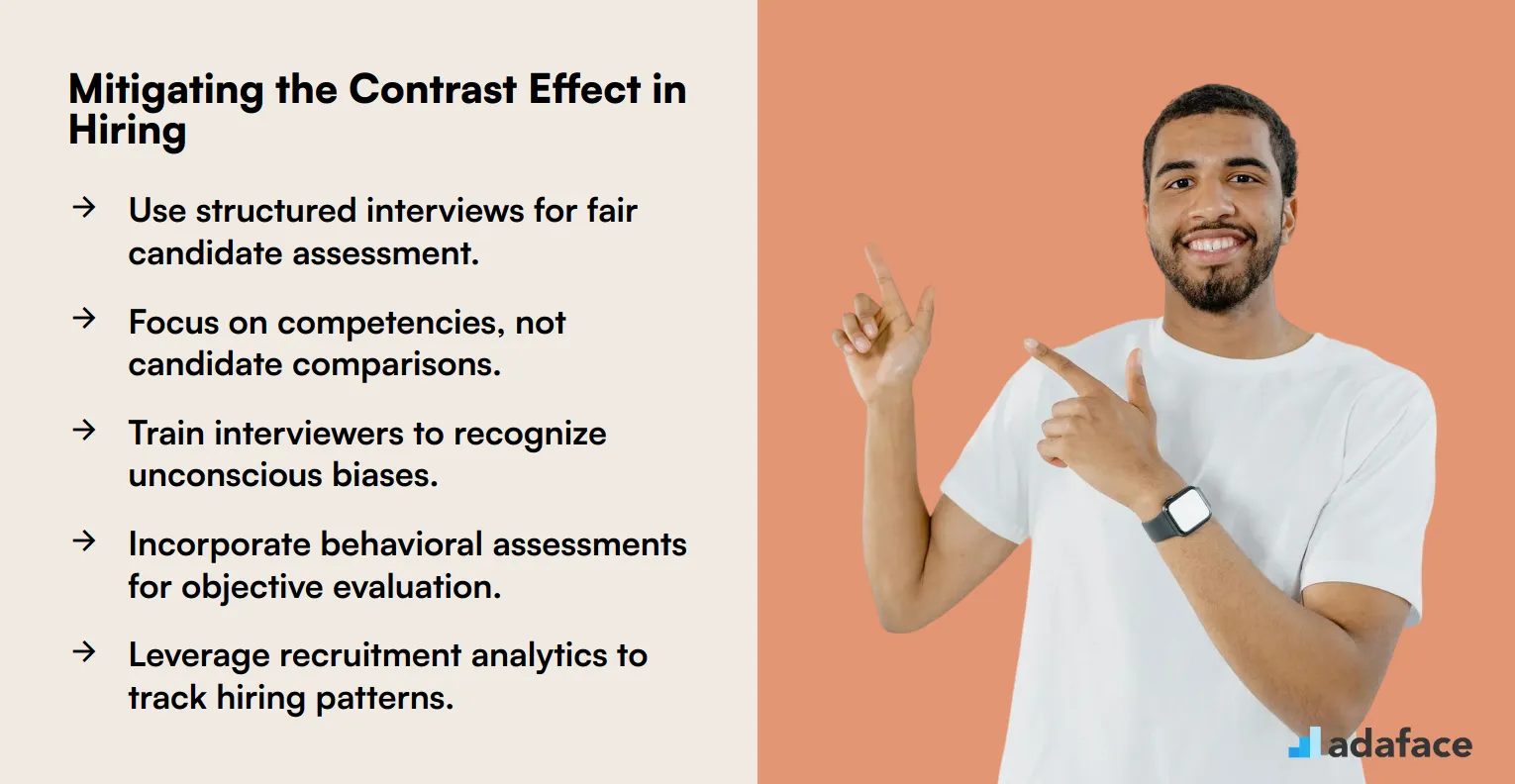The contrast effect can significantly skew recruitment outcomes by influencing how candidates are evaluated relative to one another. This bias can lead to unfair hiring decisions, impacting the overall quality of new hires and the diversity of the workplace.
Recruiters need to be aware of how the contrast effect operates in interviews to ensure a fair selection process. By implementing strategies to minimize this bias, hiring teams can improve their hiring decisions and foster a more inclusive work environment.
Table of contents
Understanding the Contrast Effect in Recruitment
The contrast effect in recruitment occurs when the evaluation of a candidate is influenced by the comparison with others. This often leads to skewed perceptions, where a candidate may appear more or less suitable based on the preceding interviewees.
For instance, if a strong candidate precedes a competent but less outstanding one, the latter might be perceived as less capable than they truly are. This can result in unfair assessments and potentially overlooking qualified candidates.
To mitigate the impact of the contrast effect, recruiters should focus on structured interviews and standardized evaluation criteria. This approach helps maintain consistency and reduces the influence of subjective comparisons.
Additionally, incorporating interviewer bias training can further aid in recognizing and minimizing such biases. By being aware of the contrast effect, interviewers can strive for more objective and fair hiring decisions.
Examples of Contrast Effect in Interviews
The contrast effect in interviews can significantly influence hiring decisions. Imagine interviewing a candidate who performs exceptionally well, followed by another who is merely average. The second candidate may seem less impressive in comparison, even if they meet all the job requirements. This effect can lead recruiters to favor candidates who stand out, rather than those who are a better fit for the role.
Another example occurs when an interviewer meets several candidates in a row with similar qualifications. If one candidate has a slightly different background, they might appear more appealing due to their uniqueness. This can result in overlooking the core skills necessary for the position, as the focus shifts to what sets the candidate apart from others.
The contrast effect can also manifest when a candidate's personality overshadows their technical skills. For instance, a highly charismatic candidate might be favored over a more reserved but technically proficient one. This can lead to hiring decisions based on personality rather than the importance of critical thinking and problem-solving skills.
In group interviews, the contrast effect might be even more pronounced. A candidate who speaks first and sets a high standard can make subsequent candidates seem less capable. This can skew the interviewer's perception, making it challenging to evaluate each candidate on their own merits.
To mitigate the contrast effect, interviewers can use structured interviews and standardized evaluation criteria. By focusing on specific competencies and qualifications, recruiters can ensure that each candidate is assessed fairly, reducing the impact of any biases.
How Contrast Effect Impacts Hiring Decisions
The contrast effect can significantly sway hiring decisions by altering the perception of a candidate's abilities based on comparisons with others. When interviewers meet a particularly strong or weak candidate, it can skew their judgment of subsequent candidates, leading to biased evaluations.
For instance, if a recruiter interviews a highly qualified candidate first, they might view the next candidate less favorably, even if they are well-qualified. This can result in overlooking potential hires who might be a great fit for the role but fall short in direct comparison to the standout candidate.
The contrast effect can also impact the evaluation of specific skills or attributes, such as leadership or communication abilities. If a candidate excels in these areas, subsequent candidates may appear lacking, even if they meet the job requirements.
To mitigate this effect, interviewers can implement structured interviews that standardize the evaluation process. This approach ensures each candidate is assessed on their own merit, reducing the likelihood of bias.
Another strategy is to include multiple interviewers in the hiring process to provide diverse perspectives and balance out individual biases. By being aware of the contrast effect, recruiters and hiring managers can make more informed and fair hiring decisions.
Strategies to Minimize Contrast Effect
Reducing the contrast effect in recruitment requires structured strategies. Implementing structured interviews can help maintain consistency across candidate evaluations, making it easier to compare candidates based on predefined criteria rather than subjective biases.
Another effective approach is using standardized assessment tools. These tools provide objective data points that can help minimize the influence of prior candidates on the evaluation of subsequent ones.
Training interviewers on unconscious biases is equally important. Educating them about the contrast effect and how it can skew perceptions ensures they are more mindful during the interview process.
Incorporating a diverse panel of interviewers can also help mitigate individual biases. Different perspectives can balance out the influence of the contrast effect, leading to a more fair evaluation of candidates.
Finally, taking notes during interviews and reviewing them before making decisions can be beneficial. This practice helps interviewers focus on each candidate's individual merits rather than being swayed by comparisons to others.
Training Interviewers to Recognize Contrast Effect
Training interviewers to recognize the contrast effect is a critical step in ensuring fair hiring practices. The contrast effect occurs when an interviewer evaluates a candidate based on comparisons with previous candidates rather than their own merits, which can lead to biased decisions.
To mitigate this, interviewers should be trained to focus on predefined criteria and competencies relevant to the role. By doing so, they can avoid being swayed by the performance of other candidates and instead make objective assessments.
Providing interviewers with structured interview formats can also help reduce the impact of the contrast effect. Structured interviews ensure each candidate is assessed using the same set of questions, promoting consistency and fairness.
Additionally, incorporating behavioral competency assessments can aid interviewers in focusing on specific skills and behaviors rather than subjective impressions. This approach helps in maintaining an unbiased evaluation process.
Regular training sessions on unconscious biases, including the contrast effect, are essential for keeping interviewers aware of their potential biases. These sessions can be supplemented with tools like recruitment analytics to track and analyze hiring patterns, further ensuring impartiality.

Improving Hiring Processes to Reduce Bias
Reducing bias in hiring processes is crucial for creating a fair and diverse workplace. Implementing structured interviews, standardized assessments, and blind hiring techniques can help minimize the impact of contrast effect and other biases.
Develop clear job descriptions and evaluation criteria before beginning the recruitment process. This ensures all candidates are assessed against the same standards, reducing the likelihood of contrast-based comparisons.
Utilize diverse hiring panels to bring multiple perspectives to the evaluation process. This approach can help counteract individual biases and provide a more balanced assessment of each candidate.
Implement regular bias awareness training for all individuals involved in the hiring process. Educating recruiters and hiring managers about common biases, including the contrast effect, can help them recognize and mitigate these tendencies.
Consider using technology-assisted screening tools to objectively evaluate candidates' skills and qualifications. These tools can help reduce the influence of subjective judgments and provide a more consistent evaluation process.
Regularly review and analyze your hiring data to identify potential patterns of bias. By monitoring key metrics and demographics, you can spot areas for improvement and adjust your processes accordingly.
Conclusion
Understanding and addressing the contrast effect is important for making fair and unbiased hiring decisions. By recognizing how it influences perceptions, recruiters can take steps to ensure a more balanced evaluation of candidates.
Implementing strategies to minimize the contrast effect can lead to better hiring outcomes. Training interviewers and refining hiring processes are key steps in reducing bias and promoting a more equitable recruitment process.
Ultimately, being aware of this bias helps create a more inclusive and effective hiring environment. By doing so, organizations can make more informed decisions and build stronger teams.
Contrast Effect FAQs
The contrast effect in recruitment occurs when the evaluation of one candidate is influenced by the comparison with previous candidates, leading to biased hiring decisions.
The contrast effect can lead to unfair evaluations, where candidates are judged based on the strengths or weaknesses of others, rather than their own merits.
Strategies like structured interviews, consistent evaluation criteria, and interviewer training can help minimize the contrast effect in recruitment.
Recruiters should be concerned because the contrast effect can lead to biased hiring decisions, affecting workplace diversity and the overall quality of hires.
Training can increase awareness of unconscious biases, equipping interviewers with tools to identify and counteract the contrast effect during recruitment.

40 min skill tests.
No trick questions.
Accurate shortlisting.
We make it easy for you to find the best candidates in your pipeline with a 40 min skills test.
Try for freeRelated terms



